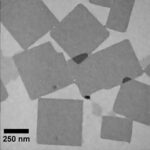Controlling the shape anisotropy of colloidal nanocrystals to modify the effects of carrier confinement
 Colloidal nanocrystals of inorganic perovskites CsPbX3 (X = Br, Cl, I) have been the subject of intense research activity since their first synthesis in 2015. Their exceptional optical and electronic properties, which one can seek to modify in controlling the shape anisotropy, make them competitive alternatives to standard II-VI semiconductors for many applications like single photon emitters, LED technology, bio-imaging etc. It is within this framework that the members of the “Photonics and Coherence of Spin” (PHOCOS) team at INSP[1] have recently investigated the emission and absorption properties of ensembles of CsPbBr3 nanocrystals in the form of nano-platelets and nano-sticks with controlled synthesis. The nature of the confinement of carriers – in one or two dimensions – is demonstrated by a joint study combining electron microscopy and optical spectroscopy.
Colloidal nanocrystals of inorganic perovskites CsPbX3 (X = Br, Cl, I) have been the subject of intense research activity since their first synthesis in 2015. Their exceptional optical and electronic properties, which one can seek to modify in controlling the shape anisotropy, make them competitive alternatives to standard II-VI semiconductors for many applications like single photon emitters, LED technology, bio-imaging etc. It is within this framework that the members of the “Photonics and Coherence of Spin” (PHOCOS) team at INSP[1] have recently investigated the emission and absorption properties of ensembles of CsPbBr3 nanocrystals in the form of nano-platelets and nano-sticks with controlled synthesis. The nature of the confinement of carriers – in one or two dimensions – is demonstrated by a joint study combining electron microscopy and optical spectroscopy.
[1] in collaboration with the “Physico-chemistry and dynamics of surfaces” team of the INSP and the Laboratory of Materials Physics of the University from Carthage, Tunisia.
Caption: Transmission electron microscopy images of films of nanocrystals (modified colloidal synthesis) in the form of very large square nano-platelets with identifiable thicknesses thanks to their emission responses and sometimes also absorption.
Reference
« Anisotropic shape of CsPbBr3 colloidal nanocrystals : from 1D to 2D confinement effects » Violette Steinmetz, Julien Ramade, Laurent Legrand, Thierry Barisien, Frédérick Bernardot, Emmanuel Lhuillier, Mathieu Bernard, Maxime Vabre, Imen Saïdi, Amal Ghribi, Kaïs Boujdaria, Christophe Testelin, Maria Chamarro Nanoscale, 12, 18978-18986 (2020).

